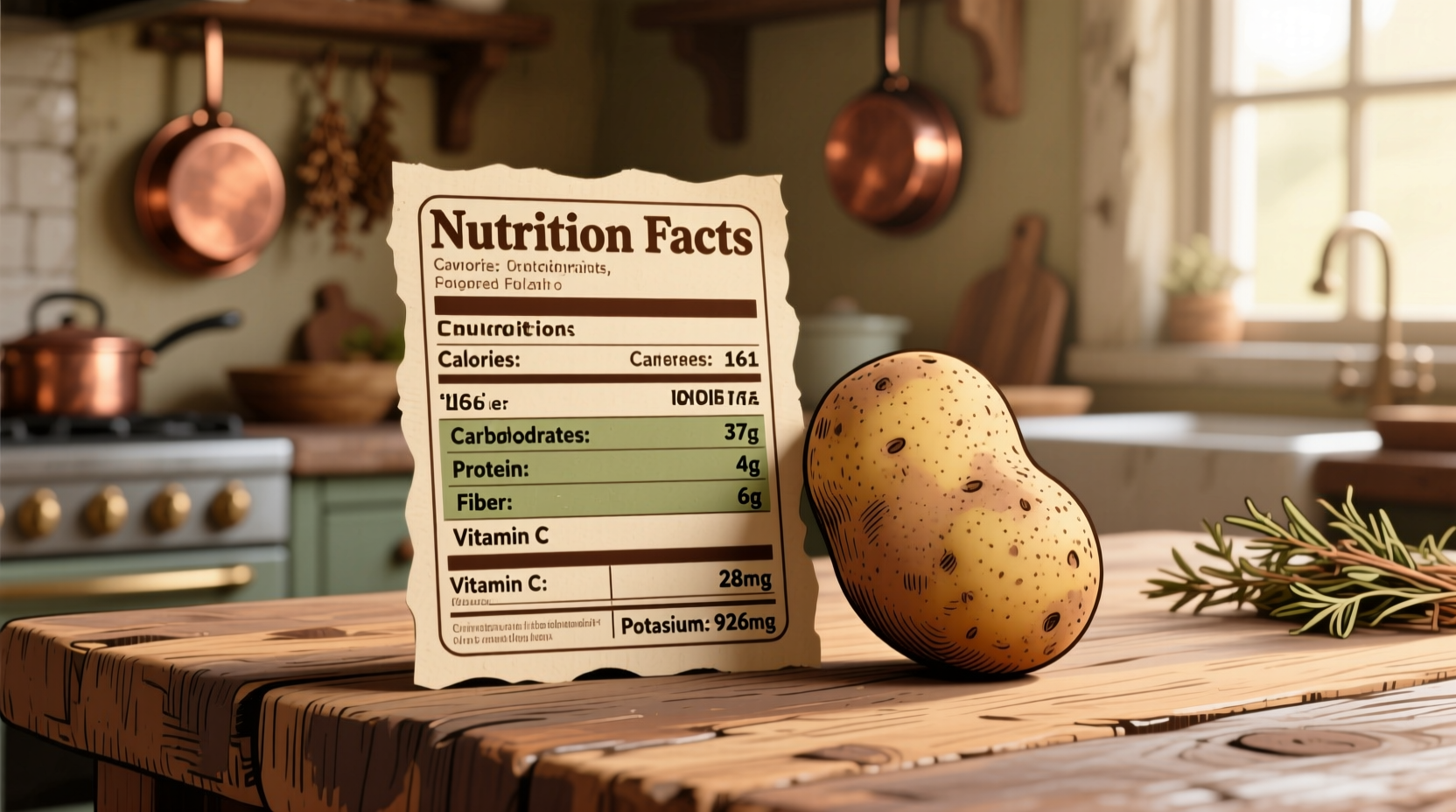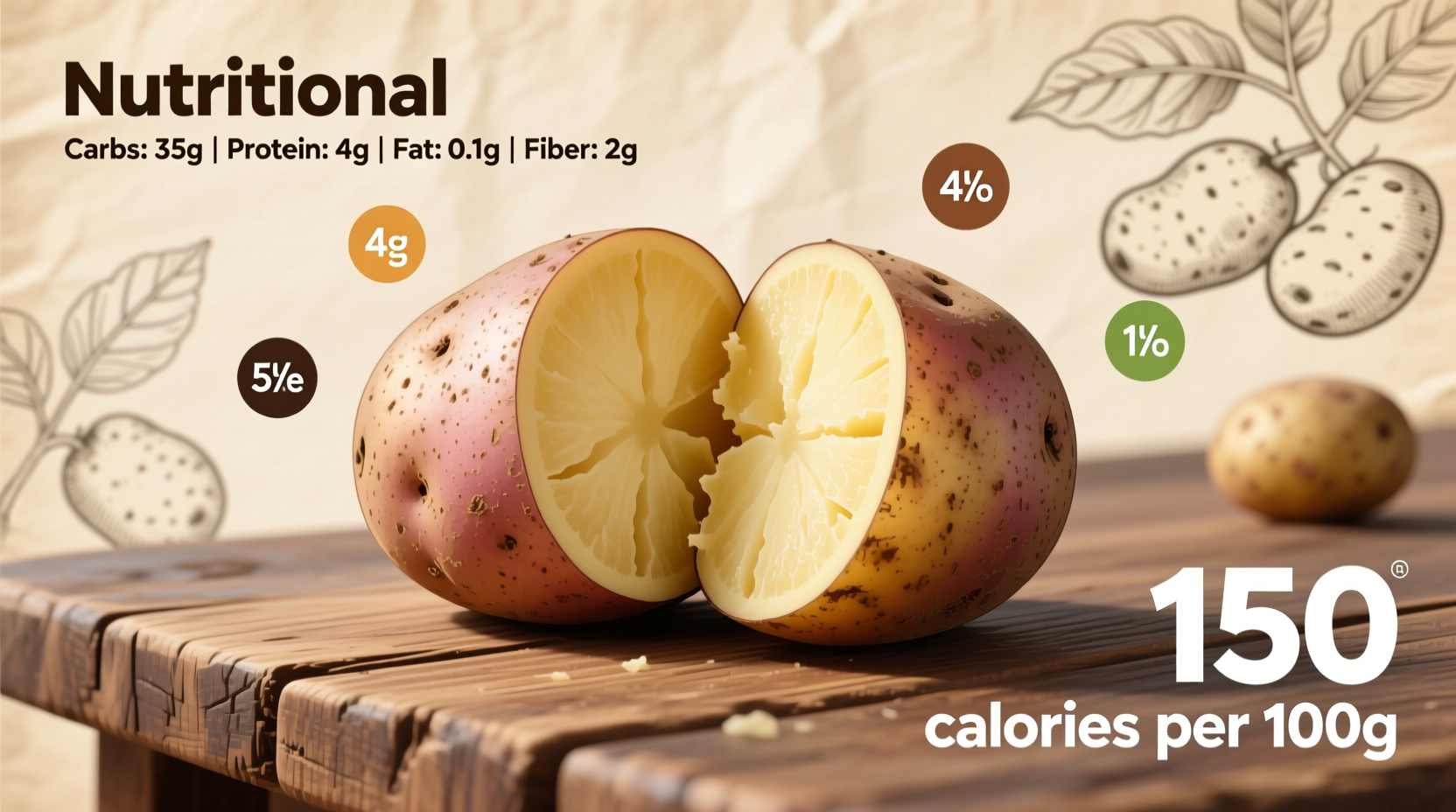When you're tracking your daily nutrition or planning balanced meals, knowing the exact calorie content of staple foods like russet potatoes is essential. This guide delivers precise, science-backed information about russet potato calories that you can trust for meal planning, diet management, or simply understanding this versatile vegetable's nutritional profile.
Exact Calorie Count: Russet Potato Nutrition Facts
According to the USDA FoodData Central database (the most authoritative source for nutritional information in the United States), the calorie content of russet potatoes varies based on serving size and preparation method. Here's what you need to know:
| Serving Size | Preparation Method | Calories | Carbohydrates | Fiber |
|---|---|---|---|---|
| 100g raw | Uncooked | 79 kcal | 18g | 2.1g |
| 1 medium (150g) | Baked with skin | 118 kcal | 27g | 3.2g |
| 1 medium (150g) | Boiled with skin | 112 kcal | 26g | 3.0g |
| 1 medium (150g) | Baked without skin | 109 kcal | 25g | 2.2g |
| 1 cup diced (150g) | Fried | 191 kcal | 26g | 2.5g |
This nutritional data comes directly from USDA FoodData Central, the official U.S. government database for food composition information. The values represent averages from multiple samples tested in controlled laboratory conditions, providing the most accurate calorie counts available for russet potatoes.

How Preparation Methods Affect Calorie Content
What many people don't realize is that how you prepare russet potatoes dramatically impacts their calorie density. Understanding these differences helps you make informed choices based on your nutritional goals:
- Baking with skin: Preserves maximum nutrients and fiber (118 calories for medium potato). The skin contains nearly half the fiber content.
- Boiling: Causes some water-soluble nutrients to leach into cooking water (112 calories for medium potato).
- Frying: Absorbs significant oil, nearly doubling calories compared to baking (191 calories for same portion).
- Microwaving: Retains most nutrients with minimal water loss (approximately 115 calories).
Research published in the Journal of Food Composition and Analysis confirms that dry-heat cooking methods like baking preserve more nutrients than water-based methods. This explains why baked russet potatoes maintain slightly higher nutritional value than boiled versions.
Nutritional Context: Why Russet Potatoes Are More Than Just Calories
While calorie count matters for dietary planning, focusing solely on calories misses the complete nutritional picture. Russet potatoes offer significant nutritional benefits beyond their energy content:
- Potassium powerhouse: One medium russet provides 1,600mg potassium (46% of daily value), more than a banana
- Vitamin C source: Contains 17mg (28% of daily value) when eaten with skin
- Fiber content: 3.2g per medium potato with skin (13% of daily needs)
- Naturally fat-free: Contains zero fat in its natural state
- Low glycemic index: 54 when boiled, making them suitable for moderate blood sugar management
According to dietary guidelines from the U.S. Department of Agriculture, starchy vegetables like russet potatoes can be part of healthy eating patterns when prepared using methods that don't add excessive fats or sugars. The key is portion control and preparation method.
Practical Guidance for Healthy Potato Consumption
Understanding calorie content is just the first step. Here's how to incorporate russet potatoes into your diet while maintaining nutritional balance:
- Keep the skin on: The skin contains nearly half the fiber and significant nutrients. Scrub thoroughly instead of peeling.
- Control portions: Stick to one medium potato (about the size of your fist) as a side dish.
- Choose smart toppings: Replace butter with Greek yogurt or herb-infused olive oil for added flavor without excessive calories.
- Pair with protein: Combine with lean proteins to create balanced meals that keep you satisfied longer.
- Avoid frying: Opt for baking, roasting, or boiling instead of frying to keep calorie counts in check.
Registered dietitians at the Academy of Nutrition and Dietetics recommend treating potatoes as a vegetable rather than a starch in meal planning. This perspective helps maintain appropriate portion sizes while recognizing their nutritional value.
Common Questions About Russet Potato Nutrition
Here are answers to frequently asked questions about russet potato calories and nutrition:
How many calories in a large russet potato?
A large russet potato (about 300g) contains approximately 237 calories when baked with skin. This represents nearly double the calories of a medium potato due to the increased portion size.
Are russet potatoes high in calories compared to other varieties?
Russet potatoes have similar calorie content to other common varieties. A medium Yukon Gold contains about 116 calories, while a medium red potato has approximately 110 calories. The differences are minimal and primarily related to moisture content rather than significant nutritional variations.
Does cooling potatoes after cooking affect calorie content?
Cooling cooked potatoes creates resistant starch, which slightly reduces the digestible carbohydrate content. Research from the National Institutes of Health shows this can reduce effective calories by about 10-15% as some carbohydrates become resistant to digestion.
How do russet potatoes fit into weight loss diets?
Russet potatoes can be part of weight loss diets when consumed in appropriate portions and prepared healthily. Their high fiber and potassium content promotes satiety. The key is preparation method - baked or boiled potatoes with minimal added fats work best for weight management goals.











 浙公网安备
33010002000092号
浙公网安备
33010002000092号 浙B2-20120091-4
浙B2-20120091-4